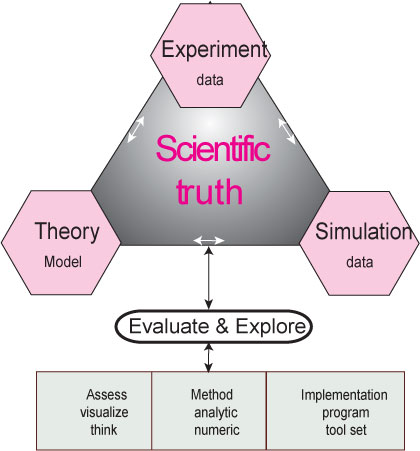| What is Computational Science?
In the 1970’s and 80’s a combination of techniques, tools and knowledge from multiple disciplines were combined with computer simulations in order to solve scientific and engineering problems. That combination is now called computational science and engineering (CSE) or eScience. When specialized to an individual field such as physics, it is called Computational Physics.
Why Teach Computational Science? Realistic problems of practical importance form the heart of CSE, but typically do not have analytic or simple solutions and so are often ignored in disciplinary education. While a decade ago computational science simulations were rare and found mainly in research programs, today they are recommended even for K-12 education as both an effective pedagogy for teaching science, math and computer science (CS) in context, as well as for teaching the scientific inquiry process itself. Yet, the academic disciplines remain slow in incorporating CSE elements into their courses.
Our vision is a systemic change in education that reflects the reality of computation having become an essential element in all sciences. Unfortunately, science and math teachers are often not prepared well for their work with computers in K-12 classrooms, and even after taking CS classes, they may not be able to explain what is occurring within the computer applications run by students.
|
 |
What is Computational Science Thinking (CST)?
-
CST is using simulation and data
processing to augment the scientific method’s search for scientific
truth, and in the process, for the realities hidden within data and revealed
by abstractions.
- How simulation, visualization,
data analysis and abstraction serve the scientific method’s
search for mechanisms and relationships within data.
- Understanding why multiple disciplines may be needed to solve a
problem, and how more understandable are those disciplines when
placed in context.
- Being able and confident enough to look inside the
computing black box, even when not an expert.
- Caring more about an accurate and reliable
answer to a particular problem than the fastest one.
-
Understanding that a scientifically “correct” answer may contain uncertainties and indeterminacies.
-
Understanding why a mathematically “exact” solution may not be as “correct” as an
approximate solution.
-
Understanding how simplicity may be present in
complexity, once we expand the way we look at objects.
-
How abstractions can lead to
simplicity.
Products: Our aim is to provide a collections of modules that can be used individually or combined to form two online/blended courses, Computational Scientific Thinking & Modeling for Teachers I, II. The courses will teach computing within the framework of solving scientific problems. Course I will be for undergraduate, pre-service teachers, and II for graduate, in-service teachers. This should lead to better preparation of educators, and consequently their students, and broader participation of underrepresented groups in computing. The proposed courses will provide practical computation integrated into the scientific problem-solving paradigm, and by giving teachers useful examples for their classes, a contextual understanding of the importance of computation, and consequently improved ability to motivate students into science.
Who Are We? We are a multi-institution collaboration among a Computational Physics educator and researcher, a Science & Math educator, a CSE education foundation, a Computational Biologist and a community college Physics teacher.
Broader Impact: It is critical that K-12 science teachers understand the essential need for computation in science as a cornerstone, not as an afterthought. There is currently a general lack of interest in STEM for K-12 students and a weak STEM preparation of the high school students entering college. Teaching science and computation in the scientific-inquiry, problem-solving context has been shown to be an efficient and stimulating approach that can address these problems. As a workforce strategy, employment data document the importance of math and computing skills, and the adaptability of a basic science education to a large number of job settings. In addition, there is presently a serious underrepresentation of various groups in computing. Yet it has been found that students not attracted to the hardware and software aspects of CS are drawn to computing after learning that it is an essential ingredient in solving societal problems. Because diversity is much greater in science than in CS, placing more computing in science is another way to increase diversity in computing, even if not in CS.
|